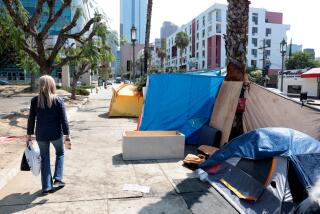Help Is Hard to Find for Addict Mothers : Learning to Cope at Treatment Center
Twelve women sit slumped in a ring of chairs. Blinds darken the room. A broken telephone rings again and again.
Angie, 26, is looking at her hands in her lap, at the floor, at the corners of the walls of the oversized living room--anywhere but into the eyes of the other women in the circle.
She is the mother of two: Antonio, 1, and Kiki, 2. And Angie, a recovering drug addict, is trying to decide whether she can care for her children while she struggles to care for herself.
“I know if I go out there and take on both kids. . . .” She pauses. “I know I’d use, with the frustration I’ve been going through here. I just want to run, and I know exactly what I’d run to--dope, if not a bottle first.”
Another pause. “What makes me feel so bad is that I see all these mothers in here who want their kids so badly and I”--she is sobbing now, covering her face with her right hand--”have a kid I don’t even want.”
This is the afternoon group at KIVA, a residential drug treatment center for women in Lakeside. In the space of 90 minutes one Friday, Angie will acknowledge her inability to raise two children, Tracy will admit she seeks out irresponsible men to take responsibility for her problems, Lori will cry out in fear of successfully completing treatment and having to re-enter the world outside.
The sessions are part of a year-long program. KIVA, founded in 1979, takes women into a drug-free environment, puts them on a rigorous schedule of chores and counseling, surrounds them with other addicted women and their children and asks them--perhaps for the first time--to take responsibility for their own lives.
“We view children as the only victim in this predicament drug addiction,” explained Steve Rusk of the McAlister Institute for Treatment and Education, the nonprofit group that operates KIVA. “The women are here through a series of poor choices.”
KIVA is the largest of the two centers in San Diego County where women can undergo drug rehabilitation in a residential setting with their children present.
There are long waits for spaces at KIVA and the other such center, the Salvation Army’s Family Recovery Program. And even after a woman is accepted at KIVA, she faces another wait before her children can leave foster care or a relative’s home to join her; state regulators allow the center to house 22 women but only eight children.
The children are central to the program’s success, Rusk said. Many women won’t seek treatment if it means being separated from their children. And for many, an important aspect of rehabilitation is learning to cope with taking care of children without leaning on the crutch of drugs.
“If you simply remove this identified patient out of the family system, put them in a place, and they come back clean laundry, it’s a shock to the family,” Rusk said. “If the child can go through this process with Mom, it works really well. There’s no shock, no adjustment period afterward.”
A typical weekday at KIVA--the name is an American Indian word for “healing place”--begins at 7 a.m. with cleaning up, group exercises and breakfast. After what Rusk calls a brief “pep rally,” the rest of the morning is spent doing chores in and around the 5,000-square-foot house.
Lunch is followed by the afternoon group counseling session and another group activity--a lesson in balancing a checkbook, for instance, or a lecture on women’s health.
In the evenings, residents go by van to Narcotics Anonymous meetings around San Diego County. Volunteers work at the bingo games that, along with resident’s payments, supplement KIVA’s $204,000 county contract.
The essence of the program is the “12 steps” to recovery used by Alcoholics Anonymous and similar self-help programs.
The steps give residents “the tools to live by that will give you the self-esteem you need to stay clean and sober, that will give you support and strength when you need it in order to stay clean,” says Jeanne McAlister, founder and executive director of the McAlister Institute.
Two out of three residents complete the program and stay clean for at least a year, McAlister said.


